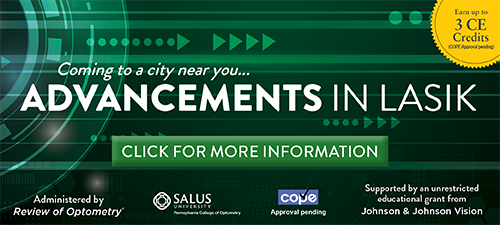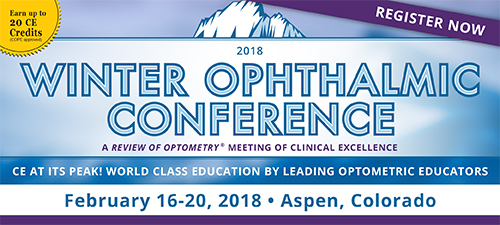
A
weekly e-journal by Art Epstein, OD, FAAO
Off the Cuff: Esthetic Optometry
What’s that I said? Esthetic optometry? I realize that you’ve probably never heard those two words used together, but trust me, over the next few years you will be hearing a lot about esthetics and optometry. In fact, I predict that this practice niche will help save and redefine our profession, keeping it relevant despite an onslaught of well-financed and carefully contrived media assaults on traditional optometric practice.
|
|||||
|
|||
| The Effect of Oral Contraceptive Pills on the Macula, the Retinal Nerve Fiber Layer and Choroidal Thickness | ||||
The aim of this study was to evaluate the effect of oral contraceptive pills (OCP) on the macula, the retinal nerve fiber layer (RNFL) and choroidal thickness (CT). A total of 24 healthy women taking monophasic OCP (3mg drospirenone and 0.03mg ethinylestradiol) for contraception for at least one year were compared with a control group of 24 healthy women who were not taking an OCP. Optical coherence tomography (OCT) was used to evaluate the posterior ocular segments, and measurements were taken in the follicular phase (day 3) of the cycle in all women.
No disparity in terms of age and body mass index between the groups was observed. In comparison between the macular region and CT between groups, researchers found that all variables except foveal center thickness and CT were significantly thinner in the OCP group. Nasal and temporal inferior parts of the RNFL and average RNFL were significantly slimmer in the study group vs. the control group. OCP resulted in several structural changes in the posterior ocular segment. Thus, researchers wrote that women using OCP for more than one year might experience some related eye problems, and suggested that OCT should be performed for these women. They added that further clinical trials researching long-period effect of OCP on the eyes would be needed. |
||||
SOURCE: Madendag Y, Acmaz G, Atas M, et al. The effect of oral contraceptive pills on the macula, the retinal nerve fiber layer, and choroidal thickness. Med Sci Monit. 2017;23:5657-61. |
||||
 |
||
Factors Associated with the Occurrence of a Fall in Subjects with Primary Open-angle Glaucoma |
||||
The aim of the study was to investigate risk factors for future falls in subjects with primary open-angle glaucoma (POAG). All participants answered the following question at their baseline ophthalmic examination: Have you had any falls in the last year? All study participants answered the same question every 12 months for three years. The means of total deviation values in the whole, superior peripheral, superior central, inferior central and inferior peripheral visual fields (VF) were calculated. The relationship between these measurements and various clinical factors against patients' future falls was analyzed using multiple linear regression.
A total of 294 POAG patients answered the baseline and follow-up fall questionnaires over three years. Among 294 subjects, 69 patients experienced a fall during the three-year follow-up. History of falls at baseline (coefficient=1.22), history of fear of falling at baseline (0.53), best corrected visual acuity in the worse eye (7.37), prevalence of diabetes mellitus (0.60) and prevalence of systemic hypertension (0.53) were selected in the optimal model. Visual acuity in the worse eye, history of falls, fear of falling, diabetes mellitus and systemic hypertension were risk factors for falling in subjects with POAG. |
||||
SOURCE: Adachi S, Yuki K, Awano-Tanabe S, et al. Factors associated with the occurrence of a fall in subjects with primary open-angle glaucoma. BMC Ophthalmol. 2017;17(1):213. |
||||

|
||
| The Association Between Visual Function and Retinal Structure in Chronic Central Serous Chorioretinopathy | ||||
The purpose of this study was to investigate the association between visual function and retinal structure in central serous chorioretinopathy (CSC). In 22 eyes of 22 chronic CSC patients with serous retinal detachments at the macula, retinal sensitivity was measured using MP3 microperimetry (Nidek). Also calculated was mean sensitivity within two degrees (MS2), four degrees (MS4) and six degrees (MS6), as well as foveal sensitivity (MS0). Retinal structure was measured using optical coherence tomography (Spectralis). The relationship between visual function (LogMAR best-corrected visual acuity [LogMAR VA], and MS0, MS2, MS4 and MS6) and serous retinal detachment height at the fovea (SRDH), central retinal thickness (CRT), macular volume (MV) and central choroidal thickness (CCT) was investigated.
Investigators found significant negative correlations between LogMAR VA and MS0 and MS2. No significant relationship was observed between LogMAR VA and SRDH although a significant negative correlation between SRDH and MS2, MS4 and MS6 was found. In CSC, serous retinal detachment significantly correlated with retinal sensitivity measured with MP3, but not with LogMAR VA. |
||||
SOURCE: Sugiura A, Fujino R, Takemiya N, et al. The association between visual function and retinal structure in chronic central serous chorioretinopathy. Sci Rep. 2017;7(1):16288. |
||||
 |
||
| News & Notes | |||||||||
| Academy Launches New Website The American Academy of Optometry’s newly designed website for the Academy and the American Academy of Optometry Foundation features improved navigation and functionality. A more modern design facilitates user ease, and the website is optimized for mobile devices and various browsers. It also includes an enhanced Fellow and Diplomate Directory. Read more.
|
|||||||||
Volk Optical Releases Next-generation Lens Cases
|
|||||||||
| Salzburg Reading Desk Available in United States The Salzburg Reading Desk, now considered 510K Class One exempt, is available to clinicians and researchers in the United States. The SRD, manufactured by SRD Vision, helps eye care professionals assess near, computer and intermediate reading speeds, and reading acuity with a high-resolution monitor and software that presents progressively smaller sentences. Stereophotogrammetry monitors the distance between the individual and the monitor. To prevent familiarization, sentences are randomized from an inventory. Other parameters such as contrast and luminance can be adjusted. Read more.
|
|||||||||
|
|||||||||
|
|||||||||
|
|||||||||
|
|||||||||
|
Optometric Physician™ (OP) newsletter is owned and published by Dr. Arthur Epstein. It is distributed by the Review Group, a Division of Jobson Medical Information LLC (JMI), 11 Campus Boulevard, Newtown Square, PA 19073. HOW TO ADVERTISE |






